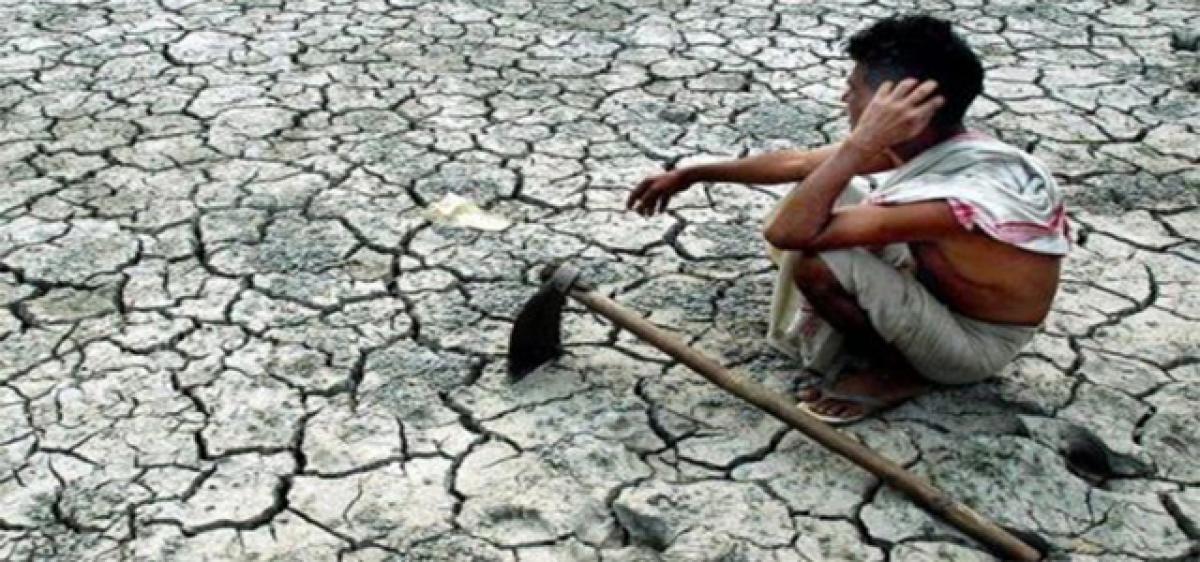Live
- Hyderabad Biryani's reputation is at risk: Cigarette Butts, Bugs, and More
- Jabardasth Varsha Launches Vivo Y300 5G Mobile in Hyderabad
- Rains continue in Tamil Nadu, standing crops hit in Cauvery delta areas
- EAM Jaishankar meets Italy's counterpart during G7 Foreign Ministers' Meeting
- Parliamentary Committee on Waqf bill to meet today
- Delhi-NCR air quality deteriorates as AQI nears 'severe' levels
- Telangana Government Issues Clarity Over Zilla Parishads Confusion
- AP Dy. CM Pawan Kalyan Condemns Arrest of ISKCON Preacher in Bangladesh
- In LS today, FM Nirmala Sitharaman to move Bills to amend banking laws
- Gold rates in Hyderabad today surges, check the rates on 27 November, 2024
Just In

There is a need to completely overhaul the Manual for Drought Management that is in force in the State of Telangana which is unscientific and outdated, demand various farmers’ organisations.
Hyderabad: There is a need to completely overhaul the Manual for Drought Management that is in force in the State of Telangana which is unscientific and outdated, demand various farmers’ organisations.
After the formation of Telangana State, the TRS administration had decided to prepare a new manual for drought management and accordingly prepared a draft manual for drought management.
Highlights:
- Faulty parameters do not project ground reality
- Unscientific methods used for data collection
- Climate changes over decades not considered
- Nizam period equipment being used
However, the new draft of the manual inherited the same shortcomings from the old manual, they point out. The criteria to assess the drought conditions cited in the new draft manual are not realistic and cannot rightly assess the drought conditions prevailing in the State, they aver.
Unfortunately, the government wants to go ahead with the new manual despite its shortcomings. The farmers say that the drought condition is erroneously being assessed in an unscientific method.
According to the Manual for Drought Management, the State has been divided into three parts considering the rainfall—areas with rainfall less than 750mm, areas with rainfall between 750 mm and 999 mm and the areas with rainfall more than 1,000 mm.
A minimum rainfall of 2.5 mm is considered as a rain-day. If there is no rain for 21 days between two rain-days it is called dry spell.
If the dry spell continues for 21 days, it is considered as mild drought and if it continues for 28 days it is termed moderate drought. If the dry spell continues for 43 days, it is considered as severe drought.
As per the present manual, if there is no rain for 20 days, it is not considered as drought. The upland crops used to survive due to moisture in the earth and air even if there is no rain for 20 days.
In the present circumstances, the moisture and humidity in the air and earth have considerably come down due to global warming and rising temperatures.
Naturally, the crops like groundnut would not survive if there is no rain for 21 days. Sarampalli Malla Reddy, vice-president of All India Farmers’ Association, said that the dry spell period should be trimmed to ten days to assess the drought condition correctly.
The manual measures rainfall between June 1 and September 30. If the rainfall is less than 20 per cent, it is considered as drought condition.
However, since the average rainfall is measured during the four months, many a time it is not considered as drought though the rainfall less than average.
For instance, though there is no rainfall during June and July and the crops dried, it is not considered as drought since there would be sufficient rainfall during August and September which is measured as average.
Experts say due to the erroneous measurement of average, it is not considered as drought year. Jaipal Reddy, South India convener of All India Farmers’ Alliance, suggested that the rainfall right from sowing to the time of harvesting should be taken as criteria for assessing the drought.
Moreover, the gauges which measure the rainfall are not accurate. They were installed during Nizam’s era that too in the erstwhile taluk headquarters. They are not installed at mandal headquarters.
If there is sufficient rainfall at the place where rain gauges are installed, not a single mandal in the area would be declared as drought-hit.
The farmers’ organisations demand installation of rainfall gauges at five places in each mandal—one at mandal headquarters and four in the four corners of the mandal.
The average rainfall could not be accurately measured unless rainfall at all the places were taken into consideration, they pointed out.
Vissa Kiran Kumar, representative of Ryot Swaraj, said that the government policies should be changed to assess the drought conditions.
Ramanjaneyulu, respresentative of Susthira Vyavasaya, averred that the government should give more priority to prevention of drought in the manual, which is now limited to relief measures.
Preventive measures should be included in the manual and the responsibility should be handed over to the Agriculture Department, he said.
The experts demand that instead of taking poor rainfall and average crop loss into consideration, other socio-economic conditions should also be included in the drought manual.
The drought policy should be prepared in such a scientific way that the conditions like migration, sale of gold, cattle and agriculture implements should also be considered as drought, they opined.

© 2024 Hyderabad Media House Limited/The Hans India. All rights reserved. Powered by hocalwire.com







